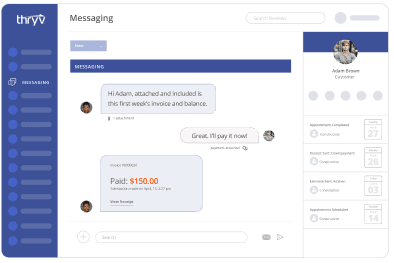Last-minute cancellations are a nightmare for small businesses. Whether you run a salon, a landscaping business, or a fitness studio, cancellations lead to lost revenue and wasted time.
That’s why having a clear and fair cancellation policy is crucial. A well-crafted policy protects your business while maintaining good customer relationships.

Free Guide: Email and Text Templates to Ask for Missing Payments
Use these free email and text templates to cut down on missed and late payments from your customers.
Download Now
In this guide, I’ll explain everything you need to know about creating a cancellation policy, including different types, examples, and enforcement strategies.
What is a cancellation policy?
A cancellation policy is a set of rules that outlines what happens when a customer cancels an appointment, subscription, or service. It typically includes how much notice is required, whether refunds or rescheduling are allowed, and any fees for last-minute cancellations.
Here’s an example of Thryv’s cancellation policy:
While this is only a piece of it, we can see that users can cancel their subscriptions after the contract term. After that, they have 60 days to reactivate their account.
This FAQ section is helpful for two reasons. First, it protects the business from any liability. Second, it answers questions that potential customers might have before purchasing. Buying software isn’t always easy, and business owners like knowing their options if they don’t like what they’ve purchased.
These are the two biggest reasons for a cancellation policy. But there are more benefits that your business can take advantage of by having one. Before we dive into the different types of cancellation policies, let’s explore more reasons why you should create one.
Why do you need a cancellation policy?
Here are the four most important reasons why you should create a cancellation policy for your business:
- It prevents lost revenue. A cancellation policy helps compensate for no-shows and last-minute cancellations.
- It sets clear expectations. When customers know your terms and conditions upfront, there are fewer disputes and arguments.
- It reduces customer churn. Customers who know they might be charged are less likely to cancel.
- It keeps operations running smoothly. A cancellation policy helps with scheduling and planning and reduces surprise cancellations that might waste time.
Let’s review a quick example. Say we own a small plumbing business and travel to all our customers. If we drive 30 minutes to someone’s house, and they tell us they no longer need our services, that wastes our time and affects our relationship with other customers. There are fewer times to book, meaning existing and potential customers may choose another company if our business is unavailable. Now, that cancellation isn’t just costing us one customer; it’s potentially costing two or three more.
Your cancellation policy helps you reduce the negative effects of no-shows and cancellations. Customers will either stick with your business because they don’t want to break your policy. Or, they’ll accept your terms, and you’ll be compensated.
Remember, cancellations are an insurance policy for your business.
This is a good time to bring up this point. Your cancellation policy should be firm but fair. Don’t trap customers into doing business with you. You might make some money in the short term, but you’re not providing a good customer experience if people constantly cancel your services. Eventually, customers will catch up, and your reputation (and sales) will take a hit.
Your cancellation policy is a backup plan. It should be simple, clear, and geared toward customers’ needs. Making it easy to cancel your services shows customers that you stand by your work and believe in what you offer. That confidence goes a long way in earning customer loyalty.
Now, let’s look at two of the most common cancellation policies: the 30-day and 24-hour policies.
What is a 30-day cancellation policy?
A 30-day cancellation policy requires customers to give at least 30 days’ notice before canceling a service, such as a membership or subscription. This policy is common for businesses that operate on a recurring billing model, such as gyms, software subscriptions, and long-term service contracts.
Why do businesses use a 30-day cancellation policy?
Here are a few reasons why you might use this policy.
- Prevents sudden revenue loss. Businesses can better predict monthly income with a 30-day notice.
- Allows time to find replacement customers. This is especially important for businesses with limited spots, like dentists, chiropractors, and fitness studios.
- Gives businesses time to process cancellations. 30 days helps businesses avoid administrative headaches and billing issues.
Example of a 30-Day Cancellation Policy
Here’s a simple example of what this policy might look like:
“Customers must provide written notice at least 30 days before the next billing cycle to cancel their membership. Failure to do so will result in one final charge before cancellation takes effect.”
And, here’s an example from a gym that uses a similar policy:
What is a 24-hour cancellation policy?
A 24-hour cancellation policy is standard for appointment-based businesses like salons, personal trainers, and home service providers such as HVAC technicians or plumbers. This policy requires customers to cancel at least 24 hours in advance to avoid a fee.
Why do businesses use a 24-hour cancellation policy?
Here are a few reasons why you might use a 24-hour cancellation policy at your business:
- Protects your time. If a customer cancels too late, you may not have enough time to fill the slot. 24 hours gives you some time to contact other customers.
- Reduces no-shows. Since customers can’t cancel at the last minute, it encourages them to commit to their appointments.
- Compensates for lost business. Like any cancellation policy, it helps cover revenue lost from late cancellations.
Example of a 24-Hour Cancellation Policy
Here’s what a 24-hour cancellation policy might look like:
“Clients must cancel at least 24 hours before their scheduled appointment to avoid a cancellation fee of 50% of the service cost. No-shows or late cancellations will be charged the full service amount.”
Whether you pick 30-day, 24-hour, or something else, let’s discuss how to make your policy clear, concise, and equitable.
How to Write a Cancellation Policy
A good cancellation policy should be fair and easy to follow. I recommend making yours easy to find, like listing it in your confirmation email or publishing an FAQ page on your website. That, plus these tips, should help you create a policy that customers know and understand.
1. Define your notice period.
Decide how much notice you require (e.g., 24 hours, 48 hours, 7 days, or 30 days). This decision should be based on your type of business. If you manage a membership or subscription-based service, you might want to use 30 days. If you have an appointment-based business (salon, medspa, home services, etc.), you can use 24-48 hours, depending on your preference.
Example: “Cancellations must be made at least 48 hours before the scheduled service.”
Here’s a business with three different notice periods in its cancellation policy. Each one is for different services, and the business explains why it has this policy. This explanation helps the customer understand why this policy is in effect.
2. Set a cancellation fee.
Determine if you will charge a flat fee, a percentage of the service cost, or the full amount for late cancellations. If your business takes deposits, you can say that clients won’t get their deposit back if they don’t cancel within your selected time frame.
Example: “Cancellations made within 24 hours of the appointment will be charged 50% of the service fee.”
Here’s a pet daycare with a similar policy. Customers can book services up to a month in advance at this business. However, once they pay for accommodations, a 10% service fee is deducted from their refund.
3. Outline how customers should cancel.
Specify whether cancellations must be made via phone, email, online booking system, or in person. I highly recommend making it possible to cancel online for a better customer experience.
Example: “To cancel your appointment, please call our office at (123) 456-7890 or email us at [email protected].”
This bridal shop lists its cancellation policy and contact details on the same page. They’re conveniently located next to each other, so customers know there are multiple ways to contact this business.
4. Explain any exceptions.
Remember, a good cancellation policy prioritizes the customer. Consider offering flexibility for automotive repairs, medical emergencies, extreme weather, or unforeseen circumstances. Not only is this the right thing to do, but it encourages customer loyalty. We’ve all been in a jam and have had to cancel an appointment. Show a little empathy and give your customers some grace.
Example: “Exceptions may be made in emergencies at our discretion.”
This dentist’s office has a 24-hour cancellation policy. However, charges are made at the company’s discretion. I like how they empathize with customers and relate to their experiences. This makes their policy clear and shows that the business cares about its customers.
5. Make it easy to read.
Some businesses have different cancellation policies for different services. For example, a painter doesn’t lose as much if they visit a customer to make an estimate. However, it would cost a lot more if they buy all the supplies and schedule their team, and then the customer cancels. Your business must protect itself in these cases, but it shouldn’t confuse the customer.
Example: “Our cancellation policy is available on our website at www.business.com/cancellation-policy.”
I really like this example from a beauty salon. It uses a chart to list its services and the cost of canceling each one.
6. Sometimes, no policy is the best policy.
Here’s a marketing secret for small businesses: your cancellation policy can also be a marketing opportunity. If your competitors charge high prices for no-shows and late cancellations, you could differentiate yourself with a free cancellation policy. While this might not be possible depending on your industry, it’s a great way to stand out from the competition and create a better customer experience.
This hotel chain offers a free cancellation policy, so guests can cancel at the last minute without any charges. This reduces stress when making big purchases like vacations and luxury items.
Sample Cancellation Policy Template
If we put it all together, here’s what a simple cancellation policy looks like:
“We understand that plans change, and we strive to be as flexible as possible. However, to be fair to our team and other clients, we require at least 24 hours’ notice for cancellations. Cancellations made with less than 24 hours notice will be charged 50% of the service fee. No-shows will be charged the full service amount. To cancel, please call (123) 456-7890 or email us at [email protected]. We appreciate your understanding!”
How to Enforce a Cancellation Policy
Having a policy is one thing, but enforcing it ensures customers take it seriously. Here’s how to make sure your policy is followed.
1. Communicate the policy clearly.
If your cancellation policy is clearly stated in multiple locations, customers know what to expect when working with your business. In fact, you should direct people to it so they can’t say they weren’t aware of your policy later on. You can do this by having your CRM automatically message customers when someone books your services.
Here are some other ways you can communicate your policy to customers:
- Include it on your website, along with appointment confirmations and service agreements.
- Verbally remind clients when they book an appointment.
- Have customers acknowledge it when signing up for a service.
2. Send appointment reminders.
Reduce cancellations by sending text, email, or phone reminders 24-48 hours before appointments. While you live and breathe your business, customers may have other things going on and forget they’ve booked you. A friendly reminder is a nice way to let customers know they have an upcoming appointment.
Here’s where you’ll need software like scheduling tools and email automation. These programs book appointments on your calendar and send reminders before each visit. You can customize the message, set its frequency, and create follow-up messages to re-engage people after each appointment. You’ll save time and stay in constant contact with your customers.
Example: “Reminder: You have an appointment tomorrow at 3 p.m. Please confirm by replying YES or calling to cancel at least 24 hours in advance.”
Tip: Thryv’s appointment-booking software can automatically remind customers for you.
3. Charge the cancellation fee consistently.
If your policy states that late cancellations will be charged, follow through. If you let it slide too often, customers won’t take it seriously.
You should include a disclaimer that special exceptions can be made at your discretion. That gives you a little wiggle room to salvage customer relationships. For example, you might make an exception if your most loyal customer wants to cancel but is upset about the fee. Your long-term revenue from that customer might far outweigh the cancellation fees. That’s why I encourage using your CRM. It can identify your most valuable customers and help you keep them happy over time.
4. Offer rescheduling options.
As we said before, your cancellation policy is a backup plan. Try to explore other options before charging a late fee. Instead of losing a client, you’ll re-engage them and return them to your business.
For instance, offer to reschedule within a specified timeframe. This way, you get paid, and your customer doesn’t have to pay a fee. Customers may enjoy their experience and make repeat purchases if you provide great service.
Example: “If you need to cancel within 24 hours, we can reschedule you for another time this week to avoid the cancellation fee.”
Write Your Cancellation Policy Today
A well-thought-out cancellation policy protects your business, values your time, and sets clear customer expectations. The key is to keep it fair, enforceable, and easy to understand.
If you haven’t already, draft your cancellation policy using the examples and templates in this guide. Once you have it, ensure it’s visible everywhere — your website, appointment confirmations, and service contracts.

Email and Text Templates to Ask for Missing Payments
Use these free email and text templates to cut down on missed and late payments from your customers.



